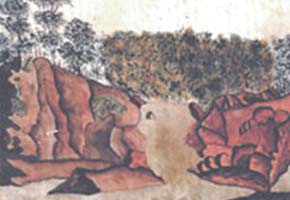

Biblioteca Mindlin’s publication of the 1827 document entitled Statistics from the Imperial Province of São Paulo describes the state’s natural and human heritage in the 19th century
Biblioteca Mindlin’s publication of the 1827 document entitled Statistics from the Imperial Province of São Paulo describes the state’s natural and human heritage in the 19th century
Biblioteca Mindlin’s publication of the 1827 document entitled Statistics from the Imperial Province of São Paulo describes the state’s natural and human heritage in the 19th century

Biblioteca Mindlin’s publication of the 1827 document entitled Statistics from the Imperial Province of São Paulo describes the state’s natural and human heritage in the 19th century
By Mônica Pileggi
Agência FAPESP – When Prince Dom Pedro de Alcântara proclaimed Brazil’s independence on September 7, 1822, what are known today as Brazilian states were then provinces of the new Empire.
Once the independent state called the Empire of Brazil had been created, an inventory had to be taken of the national territory and the natural and human heritage to better understand what was left from the colonial period before going forward with the building of a nation.
A Estatística da Imperial Província de São Paulo [Statistics from the Imperial Province of São Paulo] is the result of this study, prepared in 1827 at the request of the General Assembly. At the time, the province of São Paulo included today’s Paraná State.
The Universidade de São Paulo’s publishing house Edusp assembled a facsimile of the manuscript as well as its paleographic transcription (the original style of writing) and the modern transcription in a single publication.
According to Edusp Director-President Plínio Martins Filho, the idea for the project—which received FAPESP funding through the Publications Research Assistance Program—came from bibliophile and entrepreneur José Mindlin (1914-2010) six years ago.
“This was one of Mindlin’s final suggestions, together with the editions of the Bibliographia Brasiliana [Brazilian Bibliography] and the Ciência, História e Arte: Obras Raras e Especiais do Instituto de Biociências da Universidade de São Paulo [Science, History and Art: Rare and Special Works from the Univisidade de São Paulo’s Bioscience Institute], which were also published by Edusp,” he told Agência FAPESP. These projects also received FAPESP funding for publication.
Martins Filho explains that the motivation for producing a facsimile edition goes beyond its historical importance. “The work has beautiful cursive calligraphy, which makes it esthetically valuable. In addition, the copy of the original document allows researchers to verify the paleographic transcription at the source without visiting a library,” he explains.
And those not interested in studying the paleography but rather geographic, historical, political and economic data among other questions covered by the authors, may use the modern transcription, which boasts a modernized version of the 19th century Portuguese.
Statistical contributors
Even though the manuscript was originally produced by seven people, only one’s name is highlighted on the cover page: Lieutenant-Coronel José Antônio Teixeira Cabral.
A cartographer and engineer, Cabral’s role in producing the document was not the most significant, according to Martins Filho. Like Cabral, scholarly priest Francisco de Paula e Oliveira also participated in a small but important way with his description of the historical context.
The other parties responsible for the original work are Lieutenant-General José Arouche de Toledo Rendon, killed seven years after the report was finished, who performed the territorial study on São Paulo. As he was an attorney, Randon described the norms for distribution of land allotments, known as sesmarias.
The region’s mineral resources and other aspects of the country were explored by scholarly priest Manoel Joaquim do Amaral Gurgel. Another clergyman who contributed to the work was José Antônio dos Reis, who collected data on the farming and cattle raising sector.
Hydric and natural resources were studied by Candido Gonçalves Gomide. One interesting entry contained in the document refers to the Rio Tietê: “The shores of the Tietê are abundant with lush trees and a wonderful variety of wild fruits. It is home to copious amounts of delicious fish including Dourados (Salminus maxillosus), Saupés, Pacus (Piaractus mesopotamicus), Piracanjubas (Brycon orbignyanus), Surubins (Pseudoplatystoma coruscans), Piracambucus (Pseudoplatystoma fasciatum), Jaús (Paulicea lutkeni) and Piraquaxiaras, some weighing 30 kilos.” It’s an unimaginable scenario for inhabitants of modern day São Paulo with the polluted river that cuts through the metropolis.
Joaquim Floriano de Toledo was one of the people that most contributed to the manuscript with his detail of the coastal region of the Paulista Province. Toledo also reported on the political organization at the time, as well as commenting on the relationship between the church and state in one of the Brazilian Empire’s most important provinces.
- A Estatística da Imperial Província de São Paulo
Author: José Antônio de Teixeira Cabral
2010
Price: R$ 120
Pages: 440
Published by: www.edusp.com.br
Republish
The Agency FAPESP licenses news via Creative Commons (CC-BY-NC-ND) so that they can be republished free of charge and in a simple way by other digital or printed vehicles. Agência FAPESP must be credited as the source of the content being republished and the name of the reporter (if any) must be attributed. Using the HMTL button below allows compliance with these rules, detailed in Digital Republishing Policy FAPESP.





